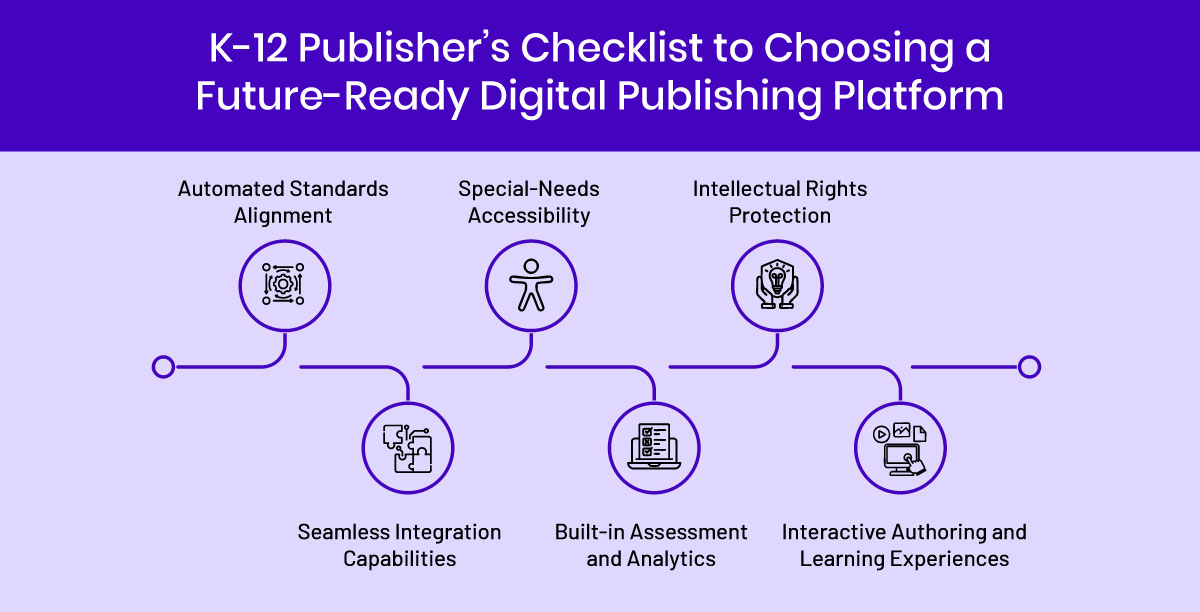
How to Choose the Right Digital Content Distribution Platform for K–12 Publishing
K-12 publishers are at a crossroads in the increasingly digitalizing education market. The choice is to either embrace evolving technologies or fade out. To put things into perspective, by the first half of 2025, 70% of global institutions had integrated digital learning tools, and 58% of them planned to enhance their investments within two years. There’s more—85% of educators believe this improves engagement, and 60% of students prefer online education. With the learning landscape shifting to digital, K-12 publishers must adopt smarter and more scalable distribution solutions. Leveraging digital content distribution platforms that enhance reach and engagement while maintaining security can boost adoption and help you grab a larger market share.
What to Look for in a K–12 Digital Publishing Solution
The right platform can make or break your content publishing and distribution game. Your chosen digital content distribution platform must go beyond delivering just content. It must enable you to deliver smart, secure, and scalable learning experiences. MagicBox’s AI-powered course authoring and assessment platform, for instance, imbues intelligence across publishing and distribution workflows.


Here’s what to prioritize:
Standards Alignment
The best digital platform for K-12 publishers is one that supports alignment with national and state academic standards, such as Common Core or NGSS. MagicBox’s course authoring tool auto-tags and enables curriculum mapping using metadata and taxonomies. This increases the chances of adoption.
LMS & SIS Integration
Look for seamless interoperability across popular digital learning platforms already in use at schools. API-based solutions employ protocols, such as LTI, OneRoster, and SSO, to ensure smooth onboarding for districts and seamless access for all users.
Accessibility
One of the best features in a digital platform for K–12 publishers is accessibility compliance. WCAG tops the list, while multilingual support, text-to-speech conversions, closed captions, and special-needs-friendly fonts make your learning materials accessible to all learners. Adopting an inclusive-by-design digital content distribution platform positions you ahead of the competition.
Built-in Assessments & Analytics
Learning is incomplete without an assessment of student progress. Opt for digital learning platforms that offer a variety of assessment and question formats, including embedded quizzes. Digital content distribution platforms that offer learning analytics dashboards to measure engagement, usage, and learning outcomes can provide actionable insights. These help publishers and educators improve instruction, curriculum planning, and course design.
Content Security
Your chosen educational content delivery platform must protect your digital IP rights through DRM, license management, encryption, and access controls. MagicBox’s DRM integrates effortlessly and offers strong security features, including offline encrypted access and timed, role-based access, which prevent unauthorized replication or sharing of learning resources.
Interactive Delivery & Authoring
Support for HTML5, SCORM, and xAPI content, as well as embedded multimedia and gamified features, enables drag-and-drop authoring to create rich, device-agnostic content. These no-code features make it one of the best-suited digital platforms for K–12 publishers with a little or no technical know-how.
Choosing a Future-Ready K–12 Digital Publishing Solution
Schools now expect more than just digitization of lesson plans and textbooks. And teachers demand interactive and curriculum-aligned learning materials that are easily accessible and seamlessly integrated into the school’s digital framework. Publishers, therefore, need to do more.
Meeting the criteria for users, however, begins long before creating or selecting the desired content. Choosing the right digital content distribution platform is foundational and critical. Addressing security requirements, diverse learning styles, workflow optimization, district-wide scalability, and other preset criteria for the platform are some of the prerequisites you cannot ignore. If you select the right digital content distribution platform, your organization can expand globally without separate overheads of compliance or resource allocation. Such platforms also provide learning analytics, including metrics for content engagement and learner outcomes to power decision-making.
Be sure to select a digital content distribution platform that aligns with your organization’s long-term vision. It should be agile enough to address today’s demands, while also responding to evolving market needs and tomorrow’s expectations.
K-12 publishers need an edtech partner that helps shape scalable learning experiences and grows alongside them while enabling the delivery of impactful, future-ready learning experiences. MagicBox’s digital course authoring and assessment platform checks all the boxes, proving how thoughtful design can power growth for educational publishers. It helps you move quickly, adapt to evolving standards, and meet the needs of both hybrid and digitally native classrooms. With education budgets increasingly tied to evidence-based decisioning, measurable outcomes, and engagement metrics, choosing the best digital content distribution platform gives publishers a competitive edge. Connect with our experts to experience Magic.
Source link




